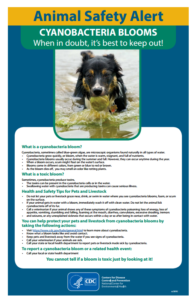Harmful Algal Blooms: A One Health Issue

Every month, the One Health Academy holds an event to bring together federal governmental departments, non-governmental organizations and private industry leaders to discuss current One Health issues. The Academy’s mission is to promote interdisciplinary collaboration among health professionals, industry, and policy makers by promoting public health, as well as environmental, food and agricultural, and economic protection.
Hibah and I were lucky enough to attend this week’s discussion on Harmful Algal Blooms (with student discounts included!). The presenting speaker was Dr. Lesley D’Anglada, a Senior microbiologist with the United States Environmental Protection Agency in the office of Science and Technology, Office of Water, who has provided advice on public health issues regarding Harmful Algal Blooms for 13 years.
There were a diverse group of professionals in attendance including those working in public health organizations, research, and governmental positions. We were also excited to see multiple veterinarians in attendance. I remembered briefly learning about the effects of harmful algal blooms in second year pathology, but was surprised to learn about the widespread affects of these blooms across multiple disciplines.
Harmful algal blooms occur when there is overgrowth of algae in marine or fresh water due the combination of sunlight, slow-moving water and increased nutrients (nitrogen and phosphorus). This is often exacerbated by nutrient pollution from human activities including agriculture, stormwater, wastewater, fossil fuels and fertilizer waste from people’s homes. These algal blooms can produce cyanotoxins that have widespread affects on health of people and animals, environment and the economy. The EPA summarizes the secondary effects of Harmful Algal blooms on their informational website. These include:
- toxin induced illnesses in people and animals: potentially causing gastrointestinal, neurologic, respiratory and skin symptoms
- creation of dead zones in the water resulting in poor oxygen environments for aquatic plants and animals
- increased treatment costs for drinking water as these often occur in water sources used for consumption
- and economic impact of industries that depend on clean water
According to the CDC, these blooms have occurred in every region of the United States. Upon further research, I discovered these blooms can have major economic impact near my veterinary campus on the Oregon coast. Blooms can result in the closing of beaches during shellfish harvesting seasons and can have devastating impacts on the local industry.
As we learned in the discussion, there is still much research needed on harmful algal blooms because the characteristics of these blooms are often unpredictable. Not all blooms produce toxins, toxins can form after the bloom, and toxins may last a short time in the water and be undetectable by the time the levels are measured.
For veterinarians:
There are no specific antidotes if an animal is exposed to the toxin and treatment is usually supportive. The toxin affects may vary (gastrointestinal, neurological, hepatic) so treatment is targeted toward those symptoms observed. Activated charcoal slurry has been used to bind toxins in the gut and reduce absorption.
Animals are often affected before people because they are more likely to swim in and drink these waters. It is important for veterinarians to encourage owners to keep their pets (and themselves) away from harmful algal blooms as prevention is key to avoiding potential toxic signs.
To keep pets safe:
The CDC recommends communicating to pet owners to:
- Avoid letting animals swim in water that smells bad, is discolored, has foam, scum or agal mats on the surface or contains dead animals
- Follow beach advisories in your state for harmful algal blooms
- Bring their pet in immediately if exposure to blooms is expected

Information cited in this post and further helpful information can be found on the following websites:
https://www.epa.gov/nutrientpollution/harmful-algal-blooms
https://www.cdc.gov/features/harmful-algal-blooms/index.html
http://www.health.state.mn.us/divs/idepc/diseases/hab/vet/habvetfs.pdf
